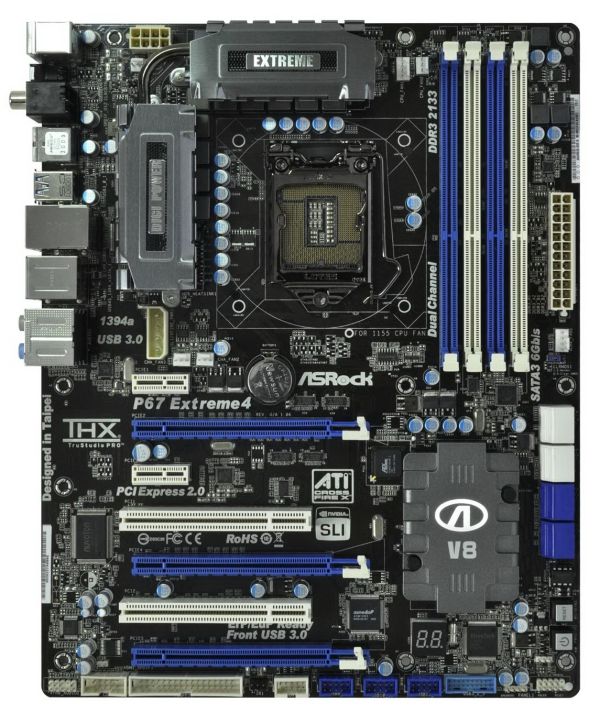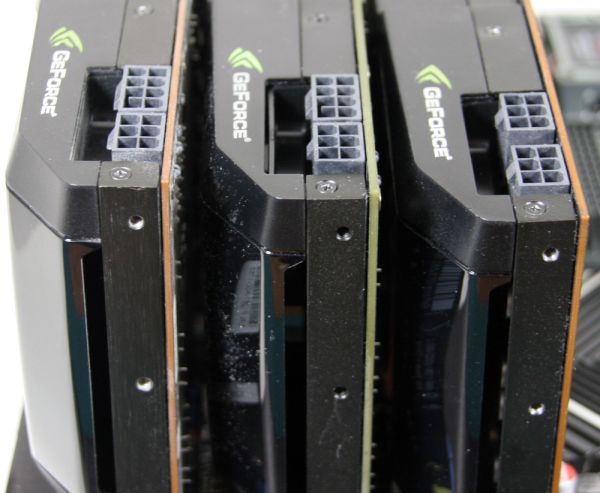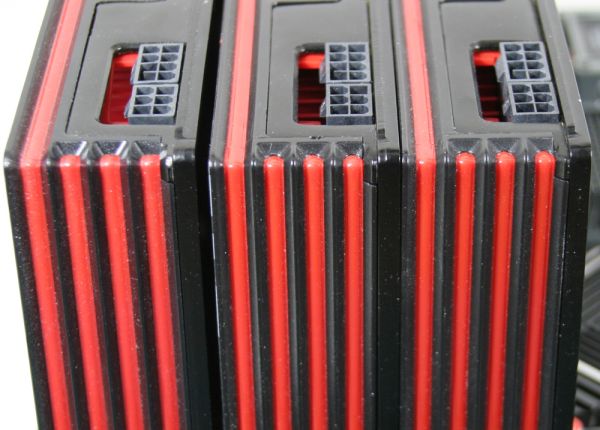A Look At Triple-GPU Performance And Multi-GPU Scaling, Part 1
by Ryan Smith on April 3, 2011 7:00 AM ESTFitting Three Video Cards in an ATX Case
I thought we’d flip our normal GPU review style on its head by starting with Power, Temperature, and Noise first. NVIDIA and AMD have both long recommended against placing high-end video cards directly next to each other, in favor of additional spacing between video cards. Indeed this is a requirement for their latest dual-GPU cards, as both the GTX 590 and 6990 draw relatively massive amounts of air using a fan mounted at the center of the card and exhaust roughly half their air inside of the case. Their reference style single-GPU cards on the other hand are fully exhausting with fans mounted towards the rear of the card. Thus multi-GPU configurations with the cards next to each other is supposed to be possible, though not ideal.
There’s a reason I want to bring this up first, and a picture is worth a thousand words.
While AMD and NVIDIA’s designs share a lot in common – a rear-mounted blower fan pushes air over a vapor chamber cooler – the shrouds and other external equipment are quite different. It’s not until we see a picture that we can appreciate just how different they are.
With the Radeon HD 6000 series, AMD’s reference designs took on a very boxy design. The cards fully live up to the idea of a “black box”; they’re enclosed on all sides with a boxy cooler and a black metal backplate. As a GPU reviewer I happen to like this design as the GPUs are easy to stack/store, and the backplate covers what would normally be the only exposed electronics on the card. The issue with this boxy design is that AMD is taking full advantage of the PCIe specification, leading to the 6900 series being the full width allowed.
NVIDIA on the other hand has always had some kind of curve in their design, normally resulting in a slightly recessed shroud around the blower intake. For the GTX 580 and GTX 570 they took a further step in recessing the shroud around this area, leading to the distinct wedge shape. At the same time NVIDIA does not use a backplate, saving precious millimeters of space. The end result of this is that even when packed like sardines, the GTX 580 and GTX 570 blowers have some space reserved for air intake.
The Radeon HD 6970 does not, and this is our problem. The picture of the 6970 in triple-CF really paints the picture, as the middle card is directly pressed up against the top card. Because these cards are so large and heavy the rear ends tend to shift and dip some when installed against a vertical motherboard – in fact this is why we can normally get away with a dense dual-CF setup since the bottom card dips a bit more – but in a triple-CF configuration the end result is that one of the cards will end up getting up-close and personal with another one.
Without outside intervention this isn’t usable. We hit 99C on the middle card in Crysis when we initially installed the three cards, and Crysis isn’t the hardest thing we run. For the purposes of our test we ultimately resorted to wedging some space between the cards with wads of paper, but this isn’t a viable long-term solution.
Unfortunately long-term alternatives are few if you want to give a triple-GPU setup more space. Our testbed uses an Asus Rampage II Extreme, which features three PCIe slots mixed among a total of 6 slots; the way it’s laid out makes it impossible to have our triple-GPU configuration setup in any other manner. Even something like the ASRock P67 Extreme4 can’t escape the fact that the ATX spec only has room for 7 slots and that when manufacturers actually use the 7th and topmost slot that it’s a short PCIe x1 slot. In short you won’t find an ATX motherboard that can fit three video cards and at the same time gives each one a slot’s worth of breathing room. For that you have to use a larger than ATX form factor.

So what’s the point of all of this rambling? With AMD’s current shroud design it’s just not practical to do triple-CF on air on an ATX motherboard. If you want to play with three AMD boards you need to think outside of the box: either use water cooling or use a larger motherboard.












97 Comments
View All Comments
Ryan Smith - Sunday, April 3, 2011 - link
I am not highly sensitive to microstuttering (aliasing on the other hand...). In my experience nothing here microstuttered, and the only thing that performed poorly was the NV 3xGTX580 setup under Bad Company 2.james.jwb - Sunday, April 3, 2011 - link
Ryan, do you think you could re-run just a single game (you choose) but with the CPU overclocked to 4.0Ghz or higher if you can (4.5ghz if possible). 3 GPU's will surely react well to this, I'd love to see the results (for 2x, too).james.jwb - Sunday, April 3, 2011 - link
just at 2560 btw :)DanNeely - Sunday, April 3, 2011 - link
Ryan posted elsewhere that the 920 he's using is from the slow end of the bell curve and isn't stable above 3.33; so until he gets a new system this is as good as it gets.PhantomKnight - Sunday, April 3, 2011 - link
This is not the only way. There are flexible PCIe cables around on eBay. I don't know how well they would work, but it would be possible to use something like this to increase the room around the cards. http://cgi.ebay.com.au/PCI-E-PCI-Express-16X-Riser... ETC7Enigma - Tuesday, April 5, 2011 - link
Interesting. I wonder if this would harm latency somehow (or reduce the amount of power the PCIe slot can supply due to essentially using an extension cord for the gpu).masterkritiker - Sunday, April 3, 2011 - link
While it is a great article, sadly it's a limited one. The dual/triple GPU test should have been done across multiple platforms, x58/890FX/P67 regardless of some platform limited pcie lanes like the P67. Let's be honest SNB systems are the ones selling like mad right now, you'll hardly convince more people w/ an x58 system to spend money upgrading their GPU to dual/triple GPUs while SNB-E is just around the corner & their x58 systems are still great for them. Trust me people will "wait"! The test could have efficiently validated anyone deciding to upgrade from single to dual/triple GPUs across multiple platforms in either a single 1080p/1600p monitor or even multiple monitors, I guess we have to wait for the test(If that will happen).b1u3 - Monday, April 4, 2011 - link
2x590GTX vs 2x6990...ypsylon - Monday, April 4, 2011 - link
Frankly I can't get my head around this test. If you have ~2000$ to blow on 3 VGAs then there is good chance you will buy 2x590* or 2x6990. It is more logical and convenient choice.Performance by a tiny fraction lower vs 3xSLI/CF (at worst - only with reference - under-clocked - models currently available), but you'll need only 2 cards, not 3. Easier to implement, less clutter inside, and if by any chance you own a motherboard with 3* slot space between 1st and 2nd x16 slot then it is absolute win-win.
piroroadkill - Monday, April 4, 2011 - link
Quite. I don't know why 6990 CF, just like 5970 CF, was almost completely ignored by AnandTech..